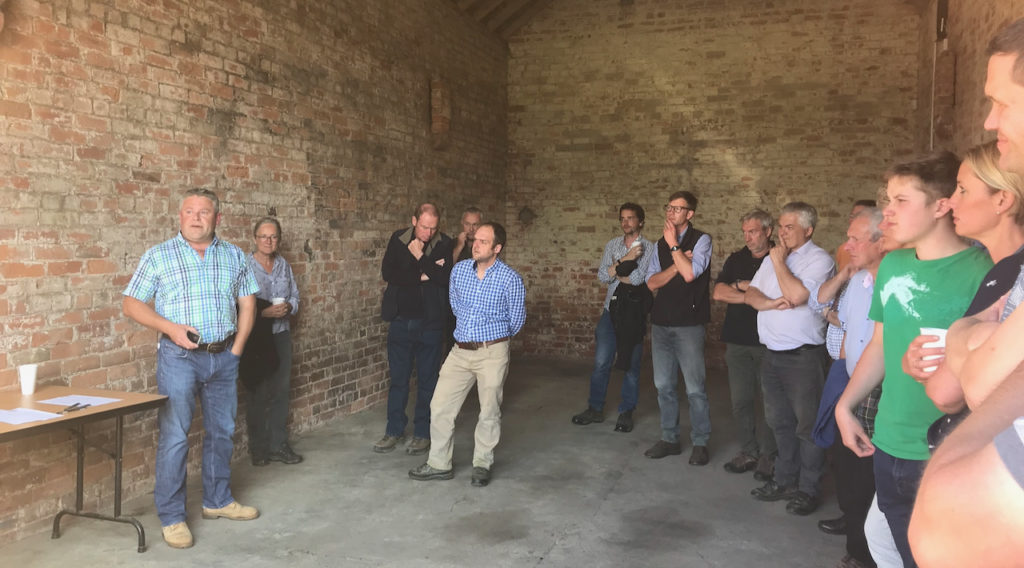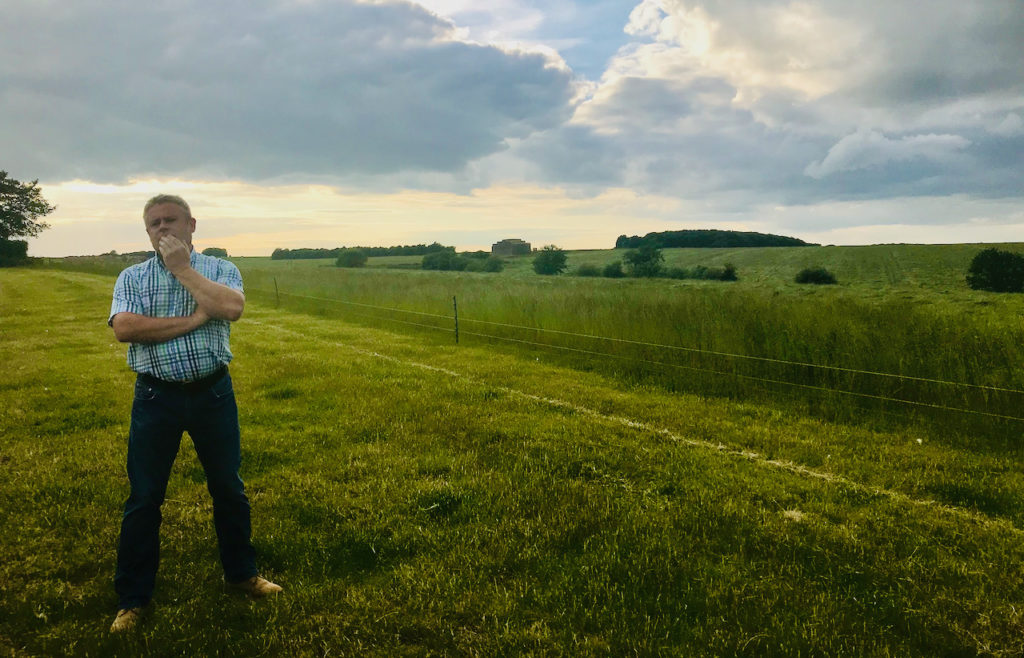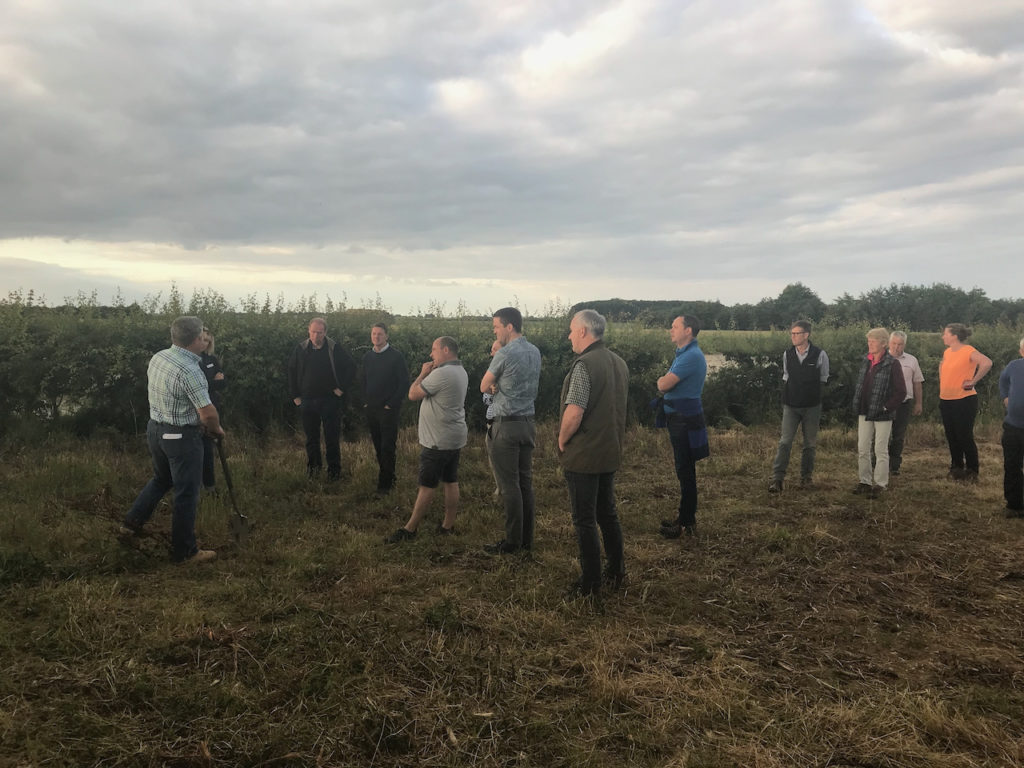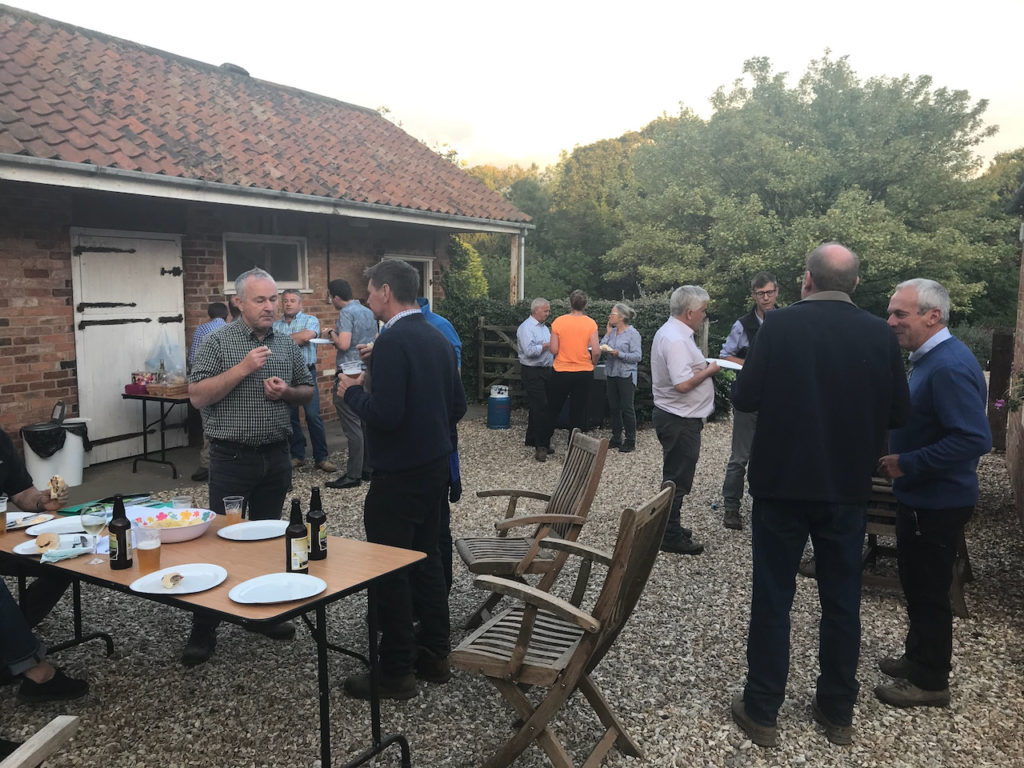
A write up of the Soil Farmer of the Year 2019 farm walk with our third place farmer Paul Davey.
Paul farms 1100 acres in Lincolnshire on the Wolds to the marshes. Spanning a mix of soil types including clay, chalk, medium and wold series, he grows a range of arable crops, runs a sheep flock of 200 ewes and a regional distribution business for local produce (which makes for an excellent barbeque at the end of the walk!). The business has evolved to its current form through a range of different practices and growing of different crops including potatoes, vining peas, and onions. The broad rotation on the farm is 2 years of ryegrass, a legume break, wheat, an oilseed break, wheat, spring barley and then back to ryegrass. This longer rotation and cropping blocks of land has allowed him to reduce overheads. The inclusion of livestock on this predominantly arable farm has been a key part of the strategy to be more resilient, sustainable and regenerative.

Paul is very keen on the benefits of livestock explaining that they are so flexible and beneficial in terms of soil health. There is an additional logistical challenge on this farm, as the land is split into 5 blocks with 29 miles the further distance to travel. The evening started with a presentation which explained the history of the farm and how they had decided to change the way they did things. He explains:
“What we’ve done hasn’t been a licence to print money, it’s been about trying to manage a ship in choppy seas. A key challenge has always been getting the equipment around the geography of the farm and get a margin at the end. So, we’ve always been on the lookout for changes to the system, but that involves finding a starting point.”
On machinery…
Within the logistical confines of the farmed area, Paul’s strategy is moving to lighter machinery and making gradual changes in terms of managing tillage and compaction. Having recently dug some soil pits and looked at rooting depths and soil structure, he has concluded that roots from the crop are capable of taking out compaction when you are travelling with lighter machinery. He has seen the impact of working with heavier machinery, as he remarks “two or three years later, you can see a wave across the field where the kit had been travelling.” He is comfortable with the use of extremely shallow cultivation to sort out any compaction that the roots can’t deal with. He is also keen on ensuring that tyre pressures are right for field conditions wherever possible (given the balance between travelling in the fields and between then on the roads).
Attentions were then drawn to the stripper header which is being used for the 6th season here on the farm. It is used for combining the ryegrass and allows the crop to be combined at the same rate as cereals, which allows for flexibility in tight weather windows, and it’s also perfect for linseed. Paul is experimenting with it to drill directly into standing stubble, maximising the soil armour. Paul comments:
“A key question for the future is how we manage crop residues and how to keep the carbon to nitrogen ratio high enough to deal with a large amount of residues.”
On grasses in the rotation…

Grasses are the building blocks of the system that is run at Girsby Grange, and Paul is a passionate advocate of the benefits that grass brings.
“Regardless of how you manage it, whether it is through growing grass for seed or grazed share farming agreements, it provides a massive benefit and up to 40 tonnes of organic matter per hectare over a three-year period. It’s an extremely valuable crop, with a big mass of rooting which brings life back to the soil, nothing works like roots do.”
The field in question was established as spring barley and undersown with Ryegrass which will be down for up to four years. Paul sees the benefit of growing the grass for seed, as alongside the soil health benefits, and a welcome returning of organic matter to the soil, his variable costs are reduced per hectare. The area of ryegrass that is grown has expanded recently as it gives them three crops, the seed crop, haylage and winter grazing for the sheep. Discussions also centred on the potential for using a grass ley as a blackgrass control mechanism as the seedbed won’t be disturbed for the three years that the crop is down.
As is often the case, attendees shared their experiences of blackgrass control and Paul explained how he had got on top of it in a particularly bad bit of the farm. He explained “I developed a strategy that went beyond population reduction to achieve eradication in 2014, which had followed a few seasons of shallow cultivations and glyphosate to reduce a triple resistant blackgrass population. I finally ploughed it then put it down to spring barley undersown with Ryegrass. I rogued the spring barley and turned the sheep out onto it, who took it back down to the ground. It was then rogued really intensively in the ryegrass and it’s not come back since.”
On grass grown for seed.
The gross margins are there is you are brave enough to grow it. The real need is plenty of drying capacity. John Fairey from Germinal explained that there was an opportunity for us to grow more in the UK, as currently we grow 9000t and import another 9000 t. There were also discussions about the potential of high sugar grasses to reduce livestock’s environmental impact. John also discussed some of the innovations that other growers were using including the potential of companion cropping; under-sowing white clover and ryegrass under spring barley by drilling them together.
Beans after grass….

Paul explained his crop protection strategy where he tries to avoid using fungicides and insecticides as much as possible. He challenges all recommendations for applications and normally only applies 50% of them. We went to visit a field of beans that looked very well. Paul explained “The grass was ploughed in after having been down for 4-5 years in November / December and the beans were drilled on the 3rd February. They have been growing since day 1 and are even across the field, with little inconsistencies in height. They are a very uncomplicated crop to manage as their ability to lock Nitrogen works well after the grass.”

After digging an obligatory soil pit, the soil looked very well structured with good levels of soil aggregation. The previous week, this field had experienced 125ml of rain in 48 hours, but there was no evidence of any ill effects. This field will be zero tilled into wheat once the beans are harvested.
Paul is farming to improve the long term sustainability of his farm and a key part of that is farming for the rotation. He comments
“It’s about taking a long term view, being flexible and brave and taking the risk. When you scratch the surface you can see the costs of our actions. Most farming practices seem to be fixing a problem by creating a different one, with this system of farming, there seems to be genuine solutions.”

